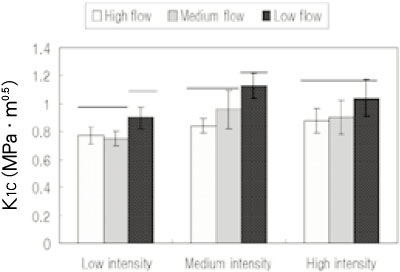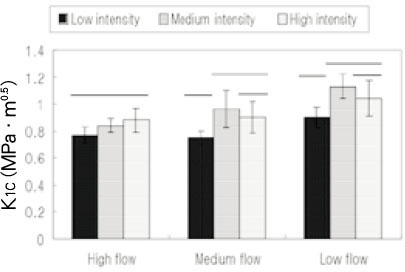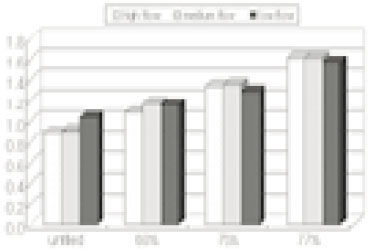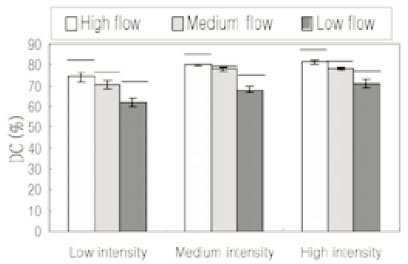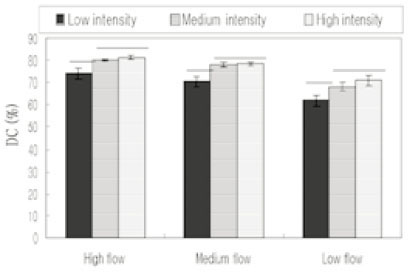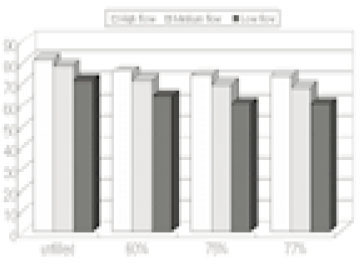J Korean Acad Conserv Dent.
2002 Jan;27(1):77-86. 10.5395/JKACD.2002.27.1.077.
Effect of resin matrix on degree of conversion and fracture toughness of dental composites
- Affiliations
-
- 1Department of Conservative Dentistry, Graduate School of Dentistry, Kyung Hee University, Korea.
- KMID: 2175550
- DOI: http://doi.org/10.5395/JKACD.2002.27.1.077
Abstract
- Current composites are made with dimethacrylate monomers and silane-treated silica microfillers, either alone or with silane treated glass fillers. The main reasons for clinical failure of dental composites are secondary caries, wear and fracture. Most of practitioner want to get a composite which is more tougher under occlusal stress, less polymerization contraction, and better handling properties in application clinically. The aim of this study was to investigate the influence of resin matrix with various flows on the physical properties such as fracture toughness and degree of conversion of the experimental resins. It was hypothesized that flexible or tough resin composites can be designed by judicious choice of monomer composition. Various flow resin matrices containing Bis-GMA, UDMA, and TEG-DMA were made by altering the proportion of the monomers. After the unfilled resins were light-cured for different light intensity, the fracture toughness(K1c) was measured according to ASTM standard using the single edge notched geometry, and degree of conversion(DC) was measured by FTIR. And experimental composites were formulated with variations in the proportion of silanated quartz and strontium glass fillers as 60, 75, and 77wt%. Also, the physical properties of composites with various filler contents were evaluated as same manner. All resulting data were compared by ANOVA/Tukeys test at 0.05 level. The results were as follows; 1. The degree of conversion of high flow resin containing less Bis-GMA was higher than that of low flow unfilled resin. 2. While the degree of conversion of unfilled resin was increased according to light intensity for polymerization, there was no significant increase with moderate and high light intensity. Also, the fracture toughness was not increased by high light intensity. 3. The fracture toughness was high in the low flow unfilled resin containing higher contents of Bis-GMA. 4. There was a significant increase for fracture toughness and a tendency for degree of conversion to be reduced when the content of fillers was increased. 5. In the experimental composites, the flow of resin matrix did not affected on the fracture toughness, even, which was decreased as increase of viscosity. These results showed that the physical properties of a dental composite could be attributed to the flow of resin matrix with relative content of monomers. Specific combination of resin monomers should be designed to fulfil the needs of specific indication for use.
MeSH Terms
Figure
Cited by 2 articles
-
Self-adhesion of low-viscosity composites to dentin surface
Tae-Hee Cho, Kyoung-Kyu Choi, Sang-Hyuk Park, Sang-Jin Park
J Korean Acad Conserv Dent. 2003;28(3):209-221. doi: 10.5395/JKACD.2003.28.3.209.The study of fractural behavior of repaired composite
Sang-Soon Park, Wook Nam, Ah-Hyang Eom, Duck-Su Kim, Gi-Woon Choi, Kyoung-Kyu Choi
J Korean Acad Conserv Dent. 2010;35(6):461-472. doi: 10.5395/JKACD.2010.35.6.461.
Reference
-
1. Full CA, Hollander WR. The composite resin restoration. A literature review part III. What the future holds. ASDC J Dent Child. 1993. 60:57–59.2. Ferracane JL. Using posterior composites appropriately. J Am Dent Assoc. 1992. 123:53–58.3. Phillips RW. Skinner's science of dental materials. 1973. 7th edition. Philadelphia, PA: WB Saunders Co..4. Asmussen E, Peutzfeldt A. Mechanical properties of heat-treated restorative resin for use in the inlay/onlay technique. Scand J Dent Res. 1990. 98:564–567.
Article5. Peutzfeldt A, Asmussen E. Influence of aldehydes on selected mechanical properties of resin composites. J Dent Res. 1992. 71:1522–1524.
Article6. Peutzfeldt A, Asmussen E. In vitro wear, hardness and conversion of diacetyl-containing and propanal-containing resin materials. Dent Mater. 1996. 12:103–108.
Article7. Ruyter IE. Vanherle , Smith , editors. Monomer systems and polymerization. In posterior composites resin dental restorative materials. 1985. Utrecht, The Netherlands: P Szulo Publishing;109–135.8. Peutzfeldt A. Resin composites in dentistry: the monomer systems. Eur J Oral Sci. 1997. 105:97–116.
Article9. Kaye GWC, Laby TH. Tables of physical and chemical constants and some mathematical functions. 1959. 12th edition. London: Longmans, Green & Co.;37.10. Asmussen E. Penetration of restorative resins into acid etched enamel (I). Acta Odontol Scand. 1977. 35:175–182.11. Ruyter IE, Oysaed H. Composites for use in posterior teeth: Composition and conversion. J Biomed Mater Res. 1987. 21:11–23.
Article12. Glenn JF. Smith DC, Williams DF, editors. Composition and properties of unfilled and composite resin restorative materials. Biocompatibility of dental materials. vol.III. Boca Raton, FL: CRC Press Inc.;98–130.13. Indrani DJ, Cook WD, Televantos F, Tyas MJ, Harcourt JK. Fracture toughness of water- aged resin composite restorative materials. Dent Mater. 1995. 11:201–207.14. Olea N, Pulgar R, Perez P, Pea-Serrano F, Rivas A, Novillo-Fertrell A, Pedraza V, Soto A, Sonnenschein C. Estrogenicity of resin-based composites and sealants used in dentistry. Environ Health Perspect. 1996. 104:298–305.
Article15. Ruyter IE, Svendsen SA. Remaining methacrylate groups in composite restorative materials. Acta Odontol Scand. 1978. 36:75–82.
Article16. Ferracane JL. Elution of leachable components from composites. J Oral Rehabil. 1994. 21:441–452.
Article17. Ferracane JL, Greener EH. The effect of resin formulation on the degree of conversion and mechanical properties of dental restorative resins. J Biomed Mater Res. 1986. 20:121–131.
Article18. Asmussen E. Restorative resins: hardness and strength vs. quantity of remaining double bonds. Scand J Dent Res. 1982. 90:484–489.
Article19. Kelly JR. Perspectives on strength. Dent Mater. 1995. 11:103–110.
Article20. Beaumont PWR, Young RJ. Slow crack growth in acrylic bone cement. J Biomed Mater Res. 1975. 9:423–439.
Article21. Mecholsky JJ. Fracture mechanics principles. Dent Mater. 1995. 11:111–112.
Article22. Griffith AA. The phenomena of rupture and flow in solids. Phil Trans Series A. 1920. 221:163–198.23. Hertzberg RW. Deformation and fracture mechanics of engineering materials. 1989. New York: John Wiley and Sons;274–283.24. Tyas MJ. Correlation between fracture properties and clinical performance of composite resins in class IV cavities. Aust Dent J. 1990. 35(1):46–49.
Article25. Mazer RB, Leinfelder KF, Russell CM. Degradation of microfilled posterior composite. Dent Mater. 1992. 8(3):185–189.
Article26. Knibbs PJ, Smart ER. The clinical performance of a posterior composite resin restorative material. J Oral Rehabil. 1992. 19(3):231–237.
Article27. Stangel I, Barolet RY. Clinical evaluation of two posterior composite resins. J Oral Rehabil. 1990. 17(3):257–268.
Article28. ASTM Standard E 399-83. Standard test method for plane-strain fracture toughness of metallic materials. 1984 Annual book of ASTM standard. 1984. Philadelphia: ASTM;592–622.29. Ferracane JL, Antonio RC, Matsumoto H. Variables affecting the fracture toughness of dental composites. J Dent Res. 1987. 66(6):1140–1145.
Article30. Ferracane JL. In vitro evaluation of composite resins. Structure-property relationships. Trans Acad Dent Mater. 1989. 2:6–35.31. Feilzer AJ, Dooren LH, De Gee AJ, Davidson CL. Influence of light intensity on polymerization shrinkage and integrity of restoration-cavity interface. Eur J Oral Sci. 1995. 103:322–326.
Article32. Asmussen E, Peutzfeldt A. Influence of UEDMA, Bis-GMA and TEGDMA on selected mechanical properties of experimental resin composites. Dent Mater. 1998. 14(1):51–56.
Article33. Tarumi H, Imazato S, Ehara A, Kato S, Ebi N, Ebisu S. Post-irradiation polymerization of composites containing Bis-GMA and TEGDMA. Dent Mater. 1999. 15(4):238–242.
Article34. Braem M, Ringer W, van Doren V, Lambrechts P, Vanherle G. Mechanical properties and filler fraction of dental composites. Dent Mater. 1989. 5:346–349.
Article35. Lloyd CH, Mitchell L. The fracture toughness of tooth coloured restorative materials. J Oral Rehabil. 1984. 11:257–272.
Article36. Kim KH, Park JH, Imai Y, Kishi T. Microfracture mechanisms of dental resin composites containing spherically-shaped filler particles. J Dent Res. 1994. 73(2):499–504.
Article37. Ferracane JL, Berge HX. Fracture toughness of experimental dental composites aged in ethanol. J Dent Res. 1995. 74(7):1418–1423.
Article38. Young RJ, Beaumont PWR. Failure of brittle polymers by slow crack growth. Part 2. Failure processes in a silica particle-filled epoxy resin composite. J Mater Sci. 1975. 10:1343–1350.39. Eliades GC, Vougiouklakis GJ, Caputo AA. Degree of double bond conversion in light-cured composites. Dent Mater. 1987. 3:19–25.
Article40. Yoshida K, Greener EH. Effects of two amine reducing agents on the degree of conversion and physical properties of an unfilled light-cured resin. Dent Mater. 1993. 9(4):246–251.
Article41. Yoshida K, Greener EH. Effect of photoinitiator on degree of conversion of unfilled light-cured resin. J Dent. 1994. 22(5):296–299.
Article42. Kawaguchi M, Fukushima T, Miyazaki K. The relationship between cure depth and transmission coefficient of visible-light-activated resin composites. J Dent Res. 1994. 73(2):516–521.
Article43. Beatty MW, Swartz ML, Moore BK, Phillips RW, Roberts TA. Effect of crosslinking agent content, monomer functionality, and repeat unit chemistry on properties of unfilled resins. J Biomed Mater Res. 1993. 27(3):403–413.
Article44. Rueggeberg FA, Jordan DM. Effect of light- tip distance on polymerization of resin composite. Int J Prosthodont. 1993. 6(4):364–367.45. Lovell LG, Newman SM, Bowman CN. The effects of light intensity, temperature, and comonomer composition on the polymerization behavior of dimethacrylate dental resins. J Dent Res. 1999. 78(8):1469–1476.
Article46. Davidson CL, Feilzer AJ. Polymerization shrinkage and polymerization shrinkage stress in polymer-based restoratives. J Dent. 1997. 25(6):435–440.
Article47. Choi KK, Condon JR, Ferracane JL. The effects of adhesive thickness on polymerization contraction stress of composite. J Dent Res. 2000. 79(3):812–817.
Article48. Davidson-Kaban SS, Davidson CL, Feilzer AJ, De Gee AJ, Erdilek N. The effect of curing light variations of bulk curing and wall-to-wall quality of two types and various shades of resin composites. Dent Mater. 1997. 13:344–352.
Article49. Sakaguchi RL, Berge HX. Reduced light energy density decreased post-gel contraction while maintaining degree of conversion in composites. J Dent. 1998. 26:695–700.
Article50. Silikas N, Watts DC. Rheology of urethane dimethacrylate and diluent formulations. Dent Mater. 1999. 15(4):257–261.
Article51. St Germain H, Swartz ML, Phillips RW, Moore BK, Roberts TA. Properties of microfilled composite resins as influenced by filler content. J Dent Res. 1985. 64:155–160.
Article52. Ferracane JL, Condon JR, Suh B. Effect of filler on degree of conversion(DC) of resins. J Dent Res (abstract). 1992. 71:598.53. Asmussen E. Clinical relevance of physical, chemical, and bonding properties of composite resins. Oper Dent. 1985. 10:61–73.54. Ferracane JL, Mitchem JC, Condon JR, Todd R. Wear and marginal breakdown of composites with various degrees of cure. J Dent Res. 1997. 76(8):1508–1516.
Article55. Jones DW, Rizkalla AS. Characterization of experimental composite biomaterials. J Biomed Mater Res. 1996. 33:89–100.
Article
- Full Text Links
- Actions
-
Cited
- CITED
-
- Close
- Share
- Similar articles
-
- Degree of Conversion and Polymerization Shrinkage of Low and High Viscosity Bulk-Fill Giomer-based and Resin-based composites
- Effect of water storage on the fracture toughness of dental resin cement used for zirconia restoration
- Fracture toughness of self-curing denture base resins with different polymerizing conditions
- Effect of pre-heating on some physical properties of composite resin
- The effect of surface finishes on flexural strength, fracture toughness of feldspathic dental porcelain

